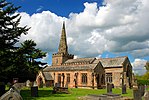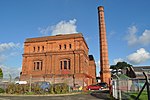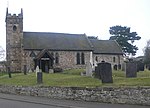River Dove, central England

The River Dove ( DUV, traditionally DOHV) is the principal river of the southwestern Peak District, in the Midlands of England and is around 45 miles (72 km) in length. It rises on Axe Edge Moor near Buxton and flows generally south to its confluence with the River Trent at Newton Solney. From there, its waters reach the North Sea via the Humber Estuary. For almost its entire course it forms the boundary between the counties of Staffordshire (to the west) and Derbyshire (to the east). The river meanders past Longnor and Hartington and cuts through a set of deep limestone gorges, Beresford Dale, Wolfscote Dale, Milldale and Dovedale.The river is a famous trout stream. Charles Cotton's Fishing House, which was the inspiration for Izaak Walton's The Compleat Angler, stands in the woods by the river near Hartington. The river's name is now usually pronounced to rhyme with "love", but its original pronunciation rhymed with "rove". This pronunciation is still used by some residents of the lower reaches of the river.
Excerpt from the Wikipedia article River Dove, central England (License: CC BY-SA 3.0, Authors, Images).River Dove, central England
Trent Lane, South Derbyshire
Geographical coordinates (GPS) Address Nearby Places Show on map
Geographical coordinates (GPS)
| Latitude | Longitude |
|---|---|
| N 52.83156 ° | E -1.58601 ° |
Address
Trent Lane
Trent Lane
DE15 0SE South Derbyshire
England, United Kingdom
Open on Google Maps









